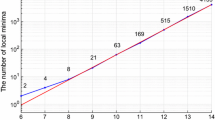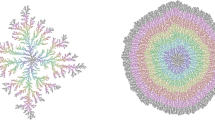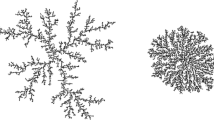Abstract
Aggregation phenomena of elementary particles into clusters has received considerable attention during the past few decades. We adopt here a stochastic approach for the modeling of these phenomena. More precisely, we formulate the problem in the following dynamical setup: given a population of n discernible atoms partitioned into p discernible (model 1) or indiscernible (model 2) groups, how does a new atom eventually connect to any of these p groups forming up a new partition of n+1 atoms into a certain amount of clusters? Nucleation is said to occur when the inserted atom does not connect (it nucleates), whereas aggregation takes place if it does (clusters coalesce). Depending on this local “logic” of pattern formation, the asymptotic structure of groups can be quite different, in the thermodynamic limit N→∞. These studies are the main purpose of this work. Understanding these aggregation phenomena requires first to derive the fragment size distributions (that is, the number P of fragments, or clusters, and the number nm of size-m fragments with m fragments with constitutive atoms), as a function of the control parameter which is chosen here to be the average number of atoms 〈N〉. As 〈N〉 approaches infinity, we derive the study of these variables in the thermodynamic limit n → ∞. It is shown, making extensive use of combinatorics, that two regimes are to be distinguished: the one of weakly connected aggregates where nucleation dominates aggregation and the one of strongly connected aggregates where aggregation dominates nucleation. In the first (“diluted”) regime, the number of clusters P(n) always diverges as n → ∞, the asymptotic equivalent of which being under control in most cases. Large deviation results are shown to be available. Concerning N m(n), distinct behaviours are observed in models 1 and 2. In the second (“condensed”) regime, the number of groups P(n) and size-m groups N m(n) may converge in the thermodynamic limit, with a special role played by the geometric and Poisson distributions. The asymptotic variables become observable macroscopically. This work is therefore aimed toward a better understanding of the fundamentals involved in clusters' formation processes.
Similar content being viewed by others
References
R. Azencott, Grandes Déviations et Applications, Cours de Saint-Flour, Lecture Notes in Math., Vol. 774 (Springer, Heidelberg, 1978).
F. Bergeron, P. Flajolet and B. Salvy, Varieties of increasing trees, in: CAAP's 92, ed. J.C. Raoult, Lecture Notes in Comput. Sci., Vol. 581 (1992) pp. 24–48.
R. Botet and Ploszajczak, Fragmentation–inactivation binary model – A new model of kinetic sequential fragmentation, in: Proceedings of the Les Houches Workshop: Fragmentation Phenomena, eds. D. Beysens, X. Campi and E. Pefferkorn (World Scientific, 1995) pp. 300–311.
X. Campi and H. Krivine, Observables in fragmentation, in: Proceedings of the Les Houches Workshop: Fragmentation Phenomena, eds. D. Beysens, X. Campi and E. Pefferkorn (World Scientific, 1995) pp. 312–321.
R.D. Cohen, Steady-state cluster size distribution in stirred suspensions, J. Chem. Soc. Faraday Trans. 86(12) (1990) 2133–2138.
R.D. Cohen, Evolution of the cluster size distribution in stirred suspensions, J. Chem. Soc. Faraday Trans. 87(8) (1991) 1163–1168.
R.D. Cohen, Development of the cluster-size distribution in flowing suspensions, AICHE J. 38(7) (1992) 1129–1134.
R.S. Ellis, Entropy, Large Deviations and Statistical Mechanics, Grundlehren Math. Wiss. (Springer, New York, 1985).
L. Comtet, Advanced Combinatorics (Reidel, Dordrecht, 1974).
I.M. Elminyawi, S. Gangopadhyay and C.M. Sorensen, Numerical solutions to the Schmoluchowski aggregation–fragmentation equations, J. Colloid Interf. Sci. 144 (1991) 315.
P. Flajolet and A. Odlyzko, Singularity analysis of generating functions, SIAM J. Discrete Math. 3(2) (1990) 216–240.
I.P. Goulden and D.M. Jackson, Combinatorial Enumeration (Wiley, New York, 1983).
P. Hammad, Information, Systémes et Distributions (Editions Cujas, Paris, 1987).
T. Huillet, Statistical physics' models of aggregation phenomena, J. Phys. A 30(6) (1997) 1849–1863.
H.-K. Hwang, Théorèmes limites pour les structures combinatoires et les fonctions arithmétiques, Ph.D. thesis, Ecole Polytechnique (December 1994).
V.F. Kolchin, Random Mappings (Optimization Software Inc., New York, 1986).
R.D. Levine and M. Tribus, eds., The Maximum Entropy Formalism (MIT Press, Cambridge, MA, 1979).
A. Meir and J.W. Moon, On the altitude of nodes in random trees, Canad. J. Math. 30 (1978) 997–1015.
J. Riordan, An Introduction to Combinatorial Analysis (Wiley, New York, 1958).
R.D. Rosenkrantz, in: Papers on Probability, Statistics and Statistical Physics, Vol. 158, ed. E.T. Jaynes (Reidel, Dordrecht, 1983).
M.R. Schroeder, Number Theory in Science and Communication (Springer, Berlin, 1989).
T. Sintes, R. Toral and A. Chakrabarti, Reversible aggregation in self-associating polymer systems, Phys. Rev. E 50 (1994) 2967–2976.
F.W. Steutel and K. Van Harn, Discrete analogues of self-decomposability and stability, Ann. Probab. 7 (1979) 893–899.
Author information
Authors and Affiliations
Rights and permissions
About this article
Cite this article
Huillet, T. Statistics of aggregates. Journal of Mathematical Chemistry 24, 187–221 (1998). https://doi.org/10.1023/A:1019126804305
Issue Date:
DOI: https://doi.org/10.1023/A:1019126804305




